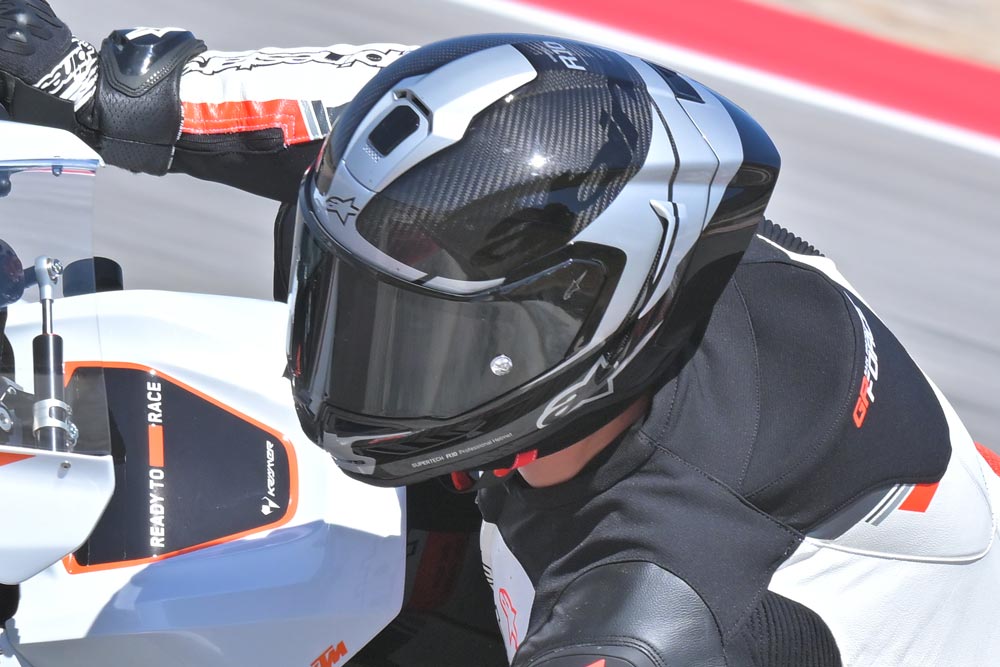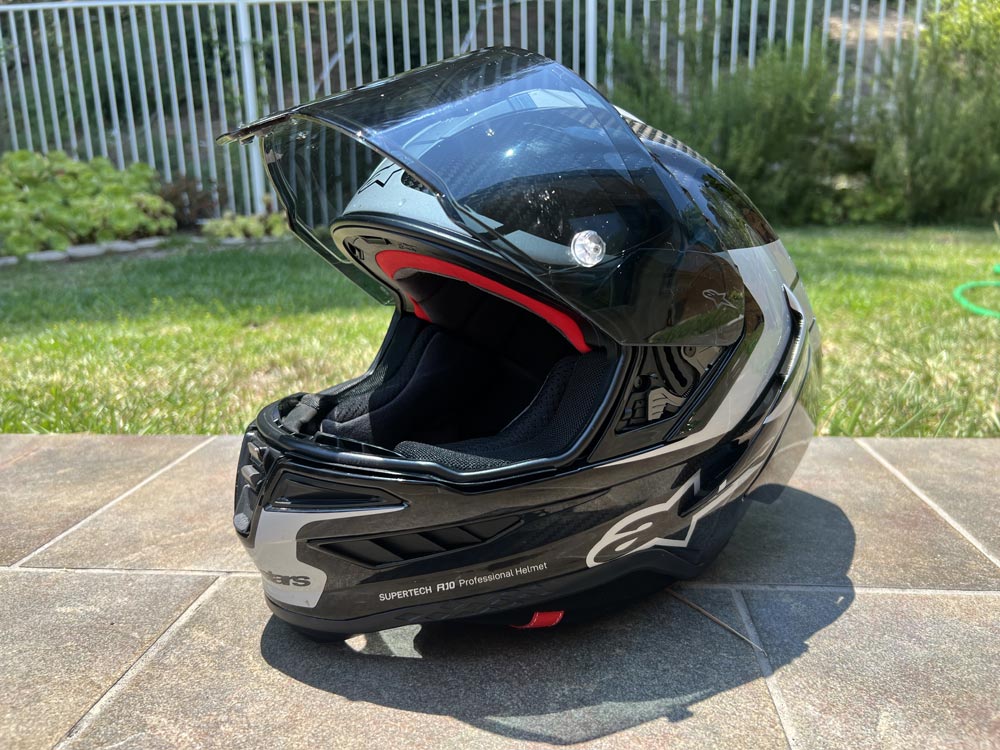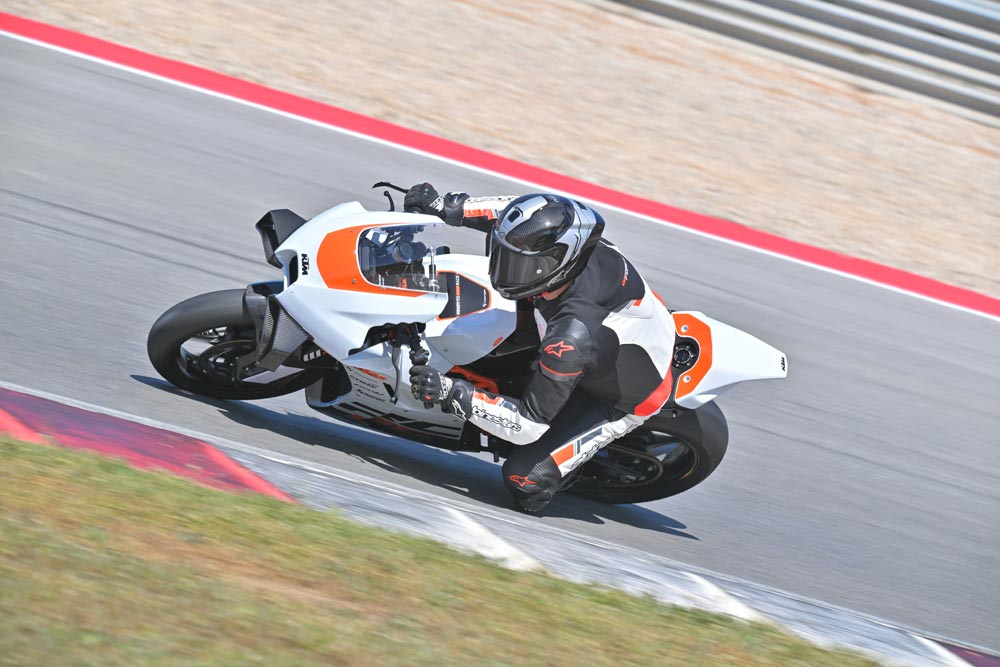Rennie Scaysbrook | July 24, 2024
Alpinestars’ Supertech R10 is the result of over a decade’s worth of development, with the finishing touches coming from MotoGP Legend Andrea Dovizioso before it was handed to the public. The S-R10 is constructed using a multi-composite combination featuring a 3K high-density carbon outer later, a uni-directional carbon composite layer, an aramid fiber layer, a fiberglass one, and it is homologated to European ECE 22.06 as opposed to the older DOT standard used in the USA.

The Alpinestars S-R10 shell was tested over and over at the company’s R&D lab and, according to the company, far exceeded the standards for ECE 22.06. According to Alpinestars, the S-R10 surpassed the standard for direct linear impacts (where there is an impact at a 90-degree angle between the helmet and an object) by 37 percent. As for rotational acceleration and oblique hits, where the impact energy comes from an angle other than a linear 90-degree/right angle, the S-R10 exceeded the standard by 65 percent.
Much of this has to do with the way Alpinestars approaches the touchy topic of rotational impact absorption. Alpinestars’ method was to create a low-friction surface on the inside of the EPS liner. The inner surface is polished smooth and coated to reduce friction, which allows the comfort liner/padding to slide against it.
This, Alpinestars says, “[reduces] rotational and oblique and linear force management, allowing the rider’s head to move independently inside of the helmet, or vice versa, which can significantly reduce the amount of force transmitted to the head, neck, brain and spine from an oblique impact, while simultaneously reducing the possibility of a concussion.”
The helmet’s A-Head Fitment System allows the rider to tilt the helmet forward or backwards, up or down, depending on the type of riding they’re doing. For example, if you’re only riding on the track, you’ll probably want the helmet to rotate slightly to the rear, thus giving you more vision when in a full tuck. Road riders may want a slightly more relaxed stance from the helmet, as they won’t be tucked behind the bubble as much.
Alpinestars claims 220-degrees of lateral and 57-degrees of vertical visibility. The shield has a locking mechanism at the front, making it unlikely the visor will come off in a crash.
The visor is an Optical Class 1 item, three millimeters in thickness, and coated with an anti-scratch and anti-fog treatment. Removal is via a toolless ratchet system.
The S-R10 comes with two separate aerodynamic spoilers—a standard and longer race version—plus a dark and clear visor and a helmet bag.
The helmet features a total of 11 ventilation ports, excluding the eye port. This includes seven intake ports—three on the chin guard and four on the top of the helmet—along with four exhaust ports with two lateral ports on the chin bar and two on the top rear of the helmet. These ports are integrated into the helmet’s shell, air coming through a series of air ducts within the inner EPS liner.
Alpinestars claims the Supertech R10 weighs 1540g/3.4 pounds but ours topped the scales a touch heavier at 1571g/3.74 pounds. Not a massive difference but still worth noting.
 Those huge side heat extractors on the jawline really do work.
Those huge side heat extractors on the jawline really do work.
Lowdown | Alpinestars Supertech R10 Helmet
List Price: $1199.95
 The most stable track helmet I’ve ever tested
The most stable track helmet I’ve ever tested
 Huge field of vision
Huge field of vision
 Inner and outer helmet adjustability
Inner and outer helmet adjustability
 Quite a stiff design, so getting it on and off can be a bit uncomfortable
Quite a stiff design, so getting it on and off can be a bit uncomfortable
 Incredibly stable with a massive field of vision, the S-R10 is a winner.
Incredibly stable with a massive field of vision, the S-R10 is a winner.
Rider Analysis | Alpinestars Supertech R10 Helmet
I’ve wanted to try this helmet for what feels like an age. I missed the international launch back in 2022 (I was racing at the Isle of Man TT, so I feel that’s a good enough excuse), and getting one finally delivered felt a bit like an early Christmas this year.
The S-R10 is by far the most modern-looking helmet on the market. Those massive side spoilers, the elongated rear, reminiscent of a cycling time trial helmet, which is more than a bit of a coincidence given reducing drag is everything in cycling.
First, what I don’t like. It is a bit tighter to get on and off than I’d have liked. The carbon construction is super stiff, but once it’s on, finding a comfortable point at which to wear it is pretty easy.
And, well, that’s it for what I don’t like.
There are three main things I like about the S-R10. The first is its stability, especially at high speeds. The S-R10 is rock solid when you’re tucked behind the bubble, as the air just whizzes over the top and doesn’t have anywhere to create pressure points on your neck. Down Portimão’s full-send front straight on the fully naked KTM 1390 Super Duke R, the S-R10 was gorgeously stable, which has the obvious advantage of reducing the fatigue on the top half of your body.
The second part I enjoyed was the huge field of vision you get from the eye port. 220° of side-to-side vision is remarkable, and I could see areas of the inside of a corner when fully leaned over I hadn’t notice before.
The third part that was immediately noticeable and welcome is the ventilation. Open all the vents, and the S-R10 flows so much air that you’d think the visor was cracked open. It’s especially noticeable on the chin next to the visor lock, as air gets ram-fed into the helmet, putting those side extractors to the test.
On the top of the S-R10, airflow is again top-notch, removing the heat build-up and just making the fit that much more comfortable.
I have not crashed in the S-R10 (I don’t intend to), so I will leave any comments about impact absorption and rotational injuries to my subconscious. However, it’s nice to see the number of times Jorge Martin and Jack Miller have thrown themselves down the road. They haven’t received any injuries above the neck, so Alpinestars must be onto something.
This is a seriously good helmet.CN
To learn more information about the Alpinestars Supertech R10 helmet, visit www.alpinestars.com